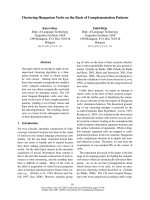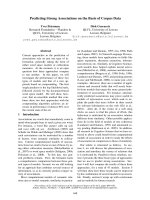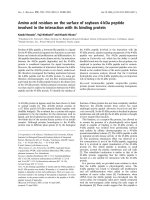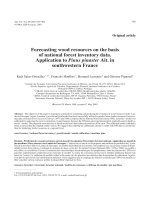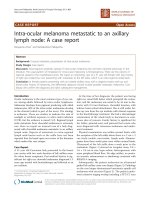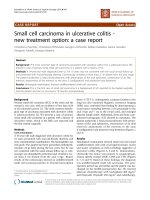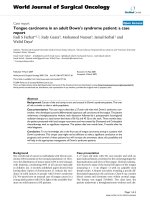Báo cáo khoa hoc:" Drug-induced hepatitis superimposed on the presence of anti-SLA antibody: a case report" potx
Bạn đang xem bản rút gọn của tài liệu. Xem và tải ngay bản đầy đủ của tài liệu tại đây (299.89 KB, 4 trang )
BioMed Central
Page 1 of 4
(page number not for citation purposes)
Journal of Medical Case Reports
Open Access
Case report
Drug-induced hepatitis superimposed on the presence of anti-SLA
antibody: a case report
Aitziber Etxagibel*
1
, M Rosa Julià
2
, Alvaro Brotons
3
, M Margarita Company
4
and Carlos Dolz
3
Address:
1
Department of Family Practice Post-graduate Unit, Palma de Mallorca, Spain,
2
Immunology Service, Son Dureta Hospital, Palma de
Mallorca, Spain,
3
Gastroenterology and Hepatology Department, Son Llàtzer Hospital, Palma de Mallorca, Spain and
4
Pathology Department, Son
Llàtzer Hospital, Palma de Mallorca, Spain
Email: Aitziber Etxagibel* - ; M Rosa Julià - ; Alvaro Brotons - ; M
Margarita Company - ; Carlos Dolz -
* Corresponding author
Abstract
Introduction: Autoimmune hepatitis is a necroinflammatory disorder of unknown etiology
characterized by the presence of circulating antibodies, hypergammaglobulinemia, and response to
immunosuppression. It has the histological features of chronic hepatitis. The onset is usually
insidious, but in some patients the presentation may be acute and occasionally severe. Certain
drugs can induce chronic hepatitis mimicking autoimmune hepatitis. Different autoantibodies have
been associated with this process but they are not detectable after drug withdrawal and clinical
resolution.
Case presentation: We describe a case of drug-induced acute hepatitis associated with
antinuclear, antisoluble liver-pancreas and anti-smooth muscle autoantibodies in a 66-year-old
woman. Abnormal clinical and biochemical parameters resolved after drug withdrawal, but six
months later anti-soluble liver-pancreas antibodies remained positive and liver biopsy showed
chronic hepatitis and septal fibrosis. Furthermore, our patient has a HLA genotype associated with
autoimmune hepatitis.
Conclusion: Patient follow-up will disclose whether our patient suffers from an autoimmune
disease and if the presence of anti-soluble liver antigens could precede the development of an
autoimmune hepatitis, as the presence of antimitochondrial antibodies can precede primary biliary
cirrhosis.
Introduction
The etiology of autoimmune hepatitis (AIH) is unknown.
The detection of non-organ and liver-related autoantibod-
ies in the absence of viral, toxic, metabolic and genetic
causes constitutes the hallmark for the diagnosis, but cir-
culating antibodies can be absent in about ten to thirty
percent of patients. In routine clinical practice, the Inter-
national Autoimmune Hepatitis Group scoring system is
usually employed. There are two types of AIH. Type 1 AIH
(AIH-1) is characterized by the detection of antismooth
muscle antibodies (anti-SMA) and/or antinuclear anti-
bodies (ANA). The presence of antineutrophil cytoplas-
mic autoantibodies (ANCA), antibodies against the
asialoglycoprotein receptor (anti-ASGP-R) and anti-solu-
Published: 28 January 2008
Journal of Medical Case Reports 2008, 2:25 doi:10.1186/1752-1947-2-25
Received: 23 June 2007
Accepted: 28 January 2008
This article is available from: />© 2008 Etxagibel et al; licensee BioMed Central Ltd.
This is an Open Access article distributed under the terms of the Creative Commons Attribution License ( />),
which permits unrestricted use, distribution, and reproduction in any medium, provided the original work is properly cited.
Journal of Medical Case Reports 2008, 2:25 />Page 2 of 4
(page number not for citation purposes)
ble liver antigens (anti-SLA) helps in the identification of
ANA/SMA-negative patients. Type 2 AIH (AIH-2) is char-
acterized by the presence of autoantibodies against liver
kidney microsomalantigens (anti-LKM type 1 or rarely
anti-LKM type 3), which contain drug-metabolizing
enzymes and/or autoantibodies against liver cytosolic
protein type 1 (anti-LC-1). [1].
More than 900 drugs, toxins, and herbs have been
reported to cause liver injury, usually with a clinical pic-
ture resembling viral hepatitis. It is difficult to identify one
drug as being responsible for liver injury because they are
often used in combination. At least 24 drugs have been
associated with drug-induced chronic hepatitis mimick-
ing AIH (DrAIH). A long interval between drug ingestion
and the start of autoimmune signs and symptoms seems
to be characteristic. At the time of diagnosis, a histological
cirrhotic phase is rarely described. ANA, anti-LKM and
SMA have been associated with DrAIH, but they are no
longer detectable after drug withdrawal together with bio-
chemical, serological and histologic resolution [2].
Anti-SLA autoantibodies have been demonstrated to be
identical to antibodies to liverpancreas antigen (anti-LP)
and now they are known as anti-SLA/LP. They are the
most specific markers for AIH, particularly in those who
lack other autoantibodies. Probably, they were underde-
tected until standardised immunoassays were available.
The anti-SLA target, a ~50 kDa cytosolic enzyme, has been
recently identified and efficient commercial ELISA tech-
niques, based on the recombinant antigen, developed.
Most authors have found anti-SLA antibodies only in
AIH-1 or in cryptogenic hepatitis and never in AIH-2. But
others have described anti-SLA positivity in a low percent-
age of AIH-2 patients. Wies et al recently showed a 30%
sensitivity and 100% specificity of anti-SLA for AIH detec-
tion [3]. Baeres et al. also described a high specificity if
confirmatory Western-blotting and a new recombinant-
ELISA were performed [4]. Occasionally anti-SLA antibod-
ies have been found in pediatric AIH-2 and hepatitis C
virus (HCV)-infected individuals. These latter findings
need confirmatory studies to elucidate the relationship
between anti-SLA and HCV infection. Shinoda et al
described their presence in patients with high levels of
autoantibodies against drug-metabolizing enzymes,
which are frequent in DrAIH, but that have been associ-
ated with the three groups of liver diseases (AIH-2, DrAIH
and viral hepatitis) [5,6].
Case presentation
A 66-year-old Caucasian woman, with a past history of
diabetes mellitus type 2, osteoporosis and no history of
liver disease, developed liver dysfunction. She presented
with fatigue, progressive jaundice, weight loss of 10 kg
and mild epigastric and right upper quadrant abdominal
pain over a period of two months. She denied any alcohol
or drug abuse or exposure to blood products. She had no
antecedents of other autoimmune disorders, and no fam-
ily history of autoimmune or liver disease. For the previ-
ous two years she had received treatment with enalapril
but this was stopped as she complained of discomfort.
She had also taken metformine for diabetes mellitus,
risendronate for osteoporosis, and herbal medicines
(Centaurea Aspera L and Coutarea latiflora DC) for
hypoglycaemia (self-medicated). Physical examination
showed moderate mucocutaneous jaundice without stig-
mata of chronic liver disease. Blood tests revealed elevated
aspartate aminotransferase (AST) 784 U/L (reference
interval 0–36), alanine aminotransferase (ALT) 794 U/L
(reference interval 0–41), serum bilirubin 6.10 mg/dl (ref-
erence interval < 1.40), and _-globulin fraction 26.90%
with selective Immunoglobulin G (IgG) elevation (2290
mg/dl). Full blood count, creatinine, urea, electrolytes
and pancreatic enzymes were within normal limits. Sero-
logical tests for viral hepatitis (HAV, HBV, HCV, CMV,
EBV) were negative. alpha-1-antitrypsin phenotype,
serum ceruloplasmin, iron and ferritin levels were nor-
mal. X-ray tests (abdominal echography and computer-
ized tomography, echoendoscopy) did not show any
abnormality. Indirect immunofluorescence (IFI) on HEp-
2 cell lines showed ANA with a speckled and cytoplasmic
pattern at 1/320 titer. Anti-SMA positivity was evidenced
by IFI on rodent liver, kidney and stomach sections ("in
house" technique) and corresponded to Factin specificity
in an enzyme linked immunoassay (ELISA) from INOVA
Diagnostics (San Diego, US). Anti-SLA detection by Dot-
blot (D-tek. Mons-BELGIUM) was confirmed by two dif-
ferent techniques; an ELISA with prokaryotically
expressed SLA protein (Euroimmun UK. Ltd. Cardiff, UK)
and an immunoprecipitation assay (IPA) as described by
Costa et al. [7]. HLA (Histocompatibility Leukocyte Anti-
gen) genotyping by PCR-SSP (Dynal Biotech, Oslo, Nor-
way) showed HLA-DRB1* 04; DR B1* 07 genotype.
Tumoral markers (CEA, CA 12.5) were negative except for
CA 19.9: 443.2 U/ml (reference interval < 37.0). Liver his-
tology disclosed severe piecemeal necrosis (interface hep-
atitis), lobular damage manifested by anisonucleosis,
ballooning degeneration, hepatocellular swelling and aci-
dophil bodies. Furthermore a severe infiltration of lym-
phocytes and neutrophils with scarce plasmatic cells and
eosinophils, and periportal and pericellular fibrosis, were
detected (figure 1A). The inflammatory infiltrates affected
most of the portal tracks with fibrosis.
Withdrawal of the medication resulted in normalization
of liver function within 3 weeks and according to the
AASLD practice guidelines published in 2002, we did not
initiate any treatment. Six months later, there was no bio-
chemical or serological alteration, IgG levels were normal
Journal of Medical Case Reports 2008, 2:25 />Page 3 of 4
(page number not for citation purposes)
and SMA and anti-F-actin were negative. ANA showed
only a speckled pattern and anti-SLA remained positive.
The second liver biopsy showed chronic hepatitis with
mild activity and septal fibrosis, despite clinical and bio-
chemical resolution. Lobular liver cell damage amelio-
rated, no bridging necrosis or multiacinar necrosis was
found and small regenerative hepatocytes were seen (fig-
ure 1B).
Conclusion
On admission, our first hypothesis was that the patient
had suffered a drug-induced hepatitis. We speculated that
a drug, probably enalapril, was the cause. Nevertheless
there are also six cases in the literature of metformin
induced hepatitis and some reports of herbal and alendr-
onate-related toxic hepatitis [8]. Our patient did not
receive any treatment but we withdrew medication. After
that, biochemical parameters fell to reference levels and
symptoms disappeared, however anti-SLA autoantibodies
remained positive.
The presence of fibrosis, at the time of diagnosis and after
6 months without medication, suggests that the patient
was suffering from a silent AIH. It is less probable, as it has
been never described, that this was a DrAIH associated
with anti-SLA, although DrAIH occasionally can develop
fibrosis. Patient follow-up after one year has not revealed
any alteration of liver enzymes.
Susceptibility for AIH-1 has been associated with the
major histocompatibility alleles DRB1*0301 and
DRB1*0401. AIH-2 has different HLA risk factors, the
DRB1*07 allele and the HLA haplotype DRB1*15-
DQB1*06. Our patient presents two AIH associated alle-
les: DRB1*04 and DRB1*07. Nowadays, there are not
enough data to establish an association between HLA
antigens and susceptibility to DrAIH, but perhaps they
play a similar role than in AIH because the target antigens
(drug-metabolizing enzymes) are common [9].
Our patient showed a moderate elevation of CA 19.9, a
tumoral marker that has also been associated with colla-
gen diseases, diabetes mellitus, alcoholic or non-alcoholic
liver disease, and acute or chronic pancreatitis. Further-
more, the combined elevation of CA 19.9 and CA 125 is
useful for identifying patients with advanced fibrosis or
cirrhosis with high specificity.
We concluded that our patient probably presented with a
drug-induced hepatitis together with an unknown AIH.
Clinical and serological follow-up will allow us to con-
firm if SLA autoantibodies could, in some cases, be a pre-
clinical marker that precedes an autoimmune disease, as
the presence of antimitochondrial antibodies can precede
primary biliary cirrhosis [10].
Competing interests
The author(s) declare that they have no competing inter-
ests.
Authors' contributions
AE was the clinical immunologist who wrote the manu-
script. AE, AB and CD were the attending physicians
responsible for providing all the clinical information. MRJ
was the immunologist responsible for the autoimmunity
section that performed immunological evaluation and
also helped to draft the manuscript. MMC was the pathol-
ogist who carried out the histological studies. All authors
read, revised and approved the final manuscript.
Consent
Written informed consent was obtained from the patient
for publication of this case report and any accompanying
images. A copy of the written consent is available for
review by the Editor-in-Chief of this journal.
Acknowledgements
Thanks to M.R. Fuster and C. Prades for their help in immunological tech-
niques.
References
1. Edward L, Krawitt MD: Autoimmune hepatitis. N Engl J Med
2006, 354:54-66.
2. Oshomoto K, Yamamoto S: Drug-induced liver injury associated
with antinuclear antibodies. Scan J Gastroenterol 2002,
11:1345-1346.
3. Wies I, Brunner S, Henninger J, Herkel J, Kanzler S, Mayer zum,
Büschenfelde KH, Lohse AW: Identification for SLA/LP autoan-
tibodies in autoimmune hepatitis. Lancet 2000, 355:1510-1515.
4. Baeres M, Herkel J, Czaja AJ, Wies I, Kanzler S, Cancado EL, Porta G,
Nishioka M, Simon T, Daehnrich C, Schlumberger W, Galle PR, Lohse
AW: Establishment of standardised SLA/LP immunoassays:
specificity for autoimmune hepatitis, worldwide occurrences
and clinical characteristics. Gut 2002, 51:259-264.
A Initial stageFigure 1
A. Initial stage. Severe piecemeal necrosis and lobular dam-
age with severe infiltration of lymphocytes and periportal and
pericellular fibrosis. B. After drug withdrawal. Chronic hepa-
titis with mild activity and septal fibrosis.
Publish with BioMed Central and every
scientist can read your work free of charge
"BioMed Central will be the most significant development for
disseminating the results of biomedical research in our lifetime."
Sir Paul Nurse, Cancer Research UK
Your research papers will be:
available free of charge to the entire biomedical community
peer reviewed and published immediately upon acceptance
cited in PubMed and archived on PubMed Central
yours — you keep the copyright
Submit your manuscript here:
/>BioMedcentral
Journal of Medical Case Reports 2008, 2:25 />Page 4 of 4
(page number not for citation purposes)
5. Shinoda M, Tanaka Y, Kuno T, Matsufuji T, Matsufuji S, Murakami Y,
Mizutani T: High levels of autoantibodies against drug-metab-
olizing enzymes in SLA/LP-positive AIH-1 sera. Autoimmunity
2004, 37:473-480.
6. Manns M, Obermayer-Straub P: Cytochromes P450 and uridine
Triphospatheglucuronosyltrasnferases: Model autoantigens
to study Drug-induced, Virus induced, and autoimmune liver
disease. Hepatology 1997, 26:1054-1066.
7. Costa M, Rodriguez-Sanchez JL, Czaja AJ, Gelpi C: Isolation and
characterization of cDNA encoding the antigenic protein of
the human tRNA(ser)sec complex recognized by autoanti-
bodies from patients with type- 1 autoimmune hepatitis. Clin
Exp Immunol 2000, 121:364-374.
8. Farrell GC: Drug-induced cirrhotic hepatitis. In Drug-induced liver
disease Edinburgh: Churchill Livingstone; 1994:413-30.
9. Czaja AJ, Strettell MD, Thomson LJ, Santrach PJ, Moore SB, Donald-
son PT, Williams R: Associations between alleles of the major
histocompatibility complex and type 1 autoimmune hepati-
tis. Hepatology 1997, 25:317-323.
10. Jones DE: Autoantigens in primary biliary cirrhosis. J Clin Pathol
2000, 53:813-821.

